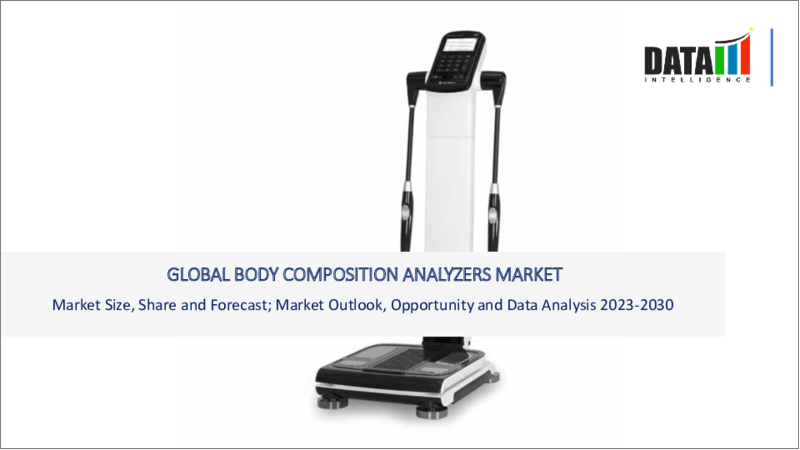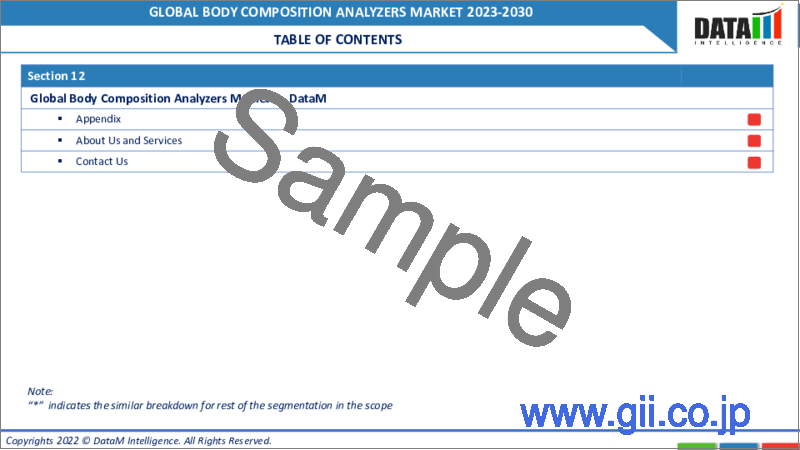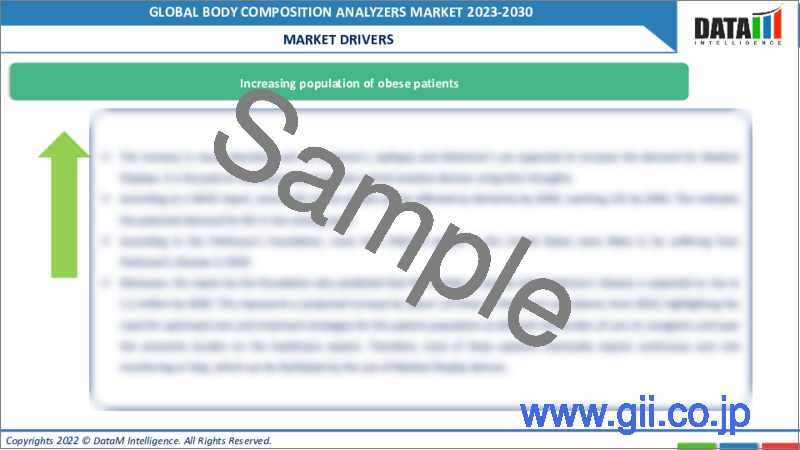|
|
市場調査レポート
商品コード
1138331
体組成計の世界市場-2022-2029Global Body Composition Analyzers Market - 2022-2029 |
||||||
|
● お客様のご希望に応じて、既存データの加工や未掲載情報(例:国別セグメント)の追加などの対応が可能です。 詳細はお問い合わせください。 |
|||||||
| 体組成計の世界市場-2022-2029 |
|
出版日: 2022年10月18日
発行: DataM Intelligence
ページ情報: 英文 180 Pages
納期: 約2営業日
|
- 全表示
- 概要
- 目次
市場力学
肥満患者の増加、健康的なライフスタイルを推進するための政府による取り組みの増加が、体組成計市場を牽引します。
健康的なライフスタイルを促進するための政府による取り組みの増加が、体組成計市場を牽引します。
過体重とその根底にある不健康なライフスタイルの主要な社会的・環境的決定要因を解決する試みとして、世界各国は政策行動を大幅にスケールアップしてきました。政府は、ライフスタイルの行動や人々の健康に対処し、健康格差や慢性疾患を減らす上で重要な役割を担っています。政府の関与には、サーベイランス、プログラム、調査、品質保証、医療へのアクセス、食事や身体活動(PA)のガイドラインなどがあります。政府を父権的と見なし、個人の選択を支持する人もいます。しかし、政府がセクターを超えて活動し、民間部門を巻き込むことで、多様なアプローチを統合する機会があります。したがって、健康的なライフスタイルを促進するための政府のイニシアチブは、体内の脂肪と無脂肪質量の割合を評価するための体組成分析器の使用に対する意識を高めるでしょう。
肥満患者の人口増加は、体組成計市場を牽引することになるでしょう。
A-Mansia Biotechによると、世界の肥満の有病率は1975年から2020年の間にほぼ3倍になっています。実際、2020年には20億人以上の成人(世界の成人人口の39%)が太り過ぎ(BMI>25)であるとされています。このうち、6億人以上が肥満(BMI>30)です。欧州では、人口の半数以上が過体重(BMI>25)、最大で30%が肥満(BMI>30)となっています。さらに、世界肥満連合が発表した「World Obesity Atlas 2022」では、2030年までに女性の5人に1人、男性の7人に1人を含む10億人が肥満と共存することになると予想しています。肥満の指標として最もよく使われるのは体重です。一般に、体重の多い人は体脂肪の量も多いです。体重の変化は、体水分、体脂肪、除脂肪組織の変化に対応しています。体組成は、体を脂肪、ミネラル、タンパク質、体水分というコアな構成要素に分ける方法です。従来の方法よりも体重をより正確に記述し、全体的な健康状態をよりよく知ることができます。体組成分析は、脂肪量、筋肉量、体脂肪率の実際の変化を示すことができます。BMI(ボディマス指数)を超えた今、BCAを行うことには多くの利点があります。健康であるためには、体重を減らすことよりも大切なことがあります。運動量を増やしたり、筋肉と脂肪の比率を向上させたりといった重要な要素があるのです。したがって、上記の記述から、予測期間中に市場が牽引されることが予想されます。
体組成計に関連するデメリットは、その市場を阻害します。
現代の技術や評価は体脂肪分析を進化させるのに役立っているが、特に選択された方法によっては、まだ一定の欠点が存在します。体脂肪の分析方法の限界は、それが実質的な誤差の余地を与えるいくつかの領域のみを考慮することです。この欠点は、同じ部位を繰り返し使用して、経時的な体脂肪の増減を確認することで回避することができます。生体電気インピーダンスは、高速で動作するため、精度に妥協せざるを得ず、コンセプトがあまり完璧ではありません。脂肪以外にも、体内の水分補給量も反応時間に影響するだろうし、食べ物なども影響します。
1が住んでいる場所に応じて、DEXAスキャンは非常に高価である可能性があり、どのように多くのセンターやフィットネスクラブ&ウェルネスセンターは、必要な機器を運ぶために周りです。これは高度な技術であり、近所や町に多くの選択肢がない場合もあります。
産業分析
体組成計市場では、アンメットニーズ、価格分析、サプライチェーン分析、規制分析など、様々な業界要因に基づいた市場の詳細な分析を行っています。
COVID-19の影響分析
COVID-19のパンデミックは、市場にかなりポジティブな影響を与えると予想されます。いくつかの研究で示唆されているように、COVID-19の感染リスクは肥満の患者でより高くなります。さらに、戸締まりや自宅での待機により、人々は以前よりも座りがちになっています。したがって、これは体組成計市場を駆動します。
体組成計の世界市場レポートでは、約45+市場データ表、40+図、180ページの構成で提供しています。
目次
第1章 調査手法と調査範囲
- 調査手法
- 調査目的および調査範囲
第2章 市場の定義と概要
第3章 エグゼクティブサマリー
- 製品別市場内訳
- エンドユーザー別市場内訳
- 地域別市場内訳
第4章 市場の力学
- 市場影響要因
- 促進要因
- 肥満患者の増加別体組成計の市場拡大
- 健康的なライフスタイルを促進するための政府別取り組みの増加が体組成計市場を牽引する
- 抑制要因
- 体組成計に関連するデメリットが市場を阻害します。
- 機会
- 影響分析
- 促進要因
第5章 産業分析
- ポーターのファイブフォース分析
- 疫学分析
- サプライチェーン分析
- 価格設定分析
- 規制分析
- 保険償還の分析
- アンメットニーズ
第6章 COVID-19の分析
- COVID-19の市場分析
- COVID-19以前の市場シナリオ
- COVID-19の現在の市場シナリオ
- COVID-19の後、あるいは将来のシナリオ
- COVID-19の中での価格ダイナミクス
- 需要-供給スペクトラム
- パンデミック時の市場に関連する政府の取り組み
- メーカーの戦略的な取り組み
- まとめ
第7章 製品別
- バイオインピーダンスアナライザー
- 二重エネルギーX線吸収測定装置
- スキンフォールドキャリパー
- 空気変位式容積脈波測定装置
- その他
第8章 エンドユーザー別
- 病院
- フィットネスクラブ・ウェルネスセンター
- その他
第9章 地域別
- 北米
- 米国
- カナダ
- メキシコ
- 欧州
- ドイツ
- 英国
- フランス
- イタリア
- スペイン
- その他欧州
- 南米
- ブラジル
- アルゼンチン
- その他の南米地域
- アジア太平洋地域
- 中国
- インド
- 日本
- オーストラリア
- その他アジア太平洋地域
- 中東・アフリカ地域
第10章 競合情勢
- 主な展開と戦略
- 企業シェア分析
- 製品ベンチマーク
- 注目すべき主要企業
- 破壊的技術を持つ企業
- スタートアップ企業
第11章 企業プロファイル
- GE Healthcare Inc.
- 企業概要
- 製品ポートフォリオと説明
- 主なハイライト
- 財務概要
- Bodystat
- Cosmed S.R.L
- Hologic Inc.
- Inbody Co. Ltd
- Jawon Medical Co. Ltd
- Maltron International Ltd
- Zhengzhou YKinspection Enterprise Co., Ltd.
- Chongqing Xishan Science & Technology Co., Ltd
- Guangzhou Lety Medical Limited(*LIST NOT EXHAUSTIVE)
第12章 DataM
Market Overview
Body Composition Analyzers Market is estimated to reach at a CAGR of 11.2% during the forecast period (2022-2029).
The body composition analyzer works based on bioelectrical impedance analysis (BIA). A method of measuring impedance by applying alternate electrical currents to a user, measuring their volume of water through impedance values, is known as bioelectrical impedance analysis. Body composition analysis can accurately show changes in muscle mass, body fat percentage, and fat mass.
Market Dynamics
The increasing population of obese patients and increasing efforts by the government to promote a healthy lifestyle will drive the body composition analyzers market.
Increasing efforts by the government to promote a healthy lifestyle will drive the body composition analyzers market.
In an attempt to solve some of the key social and environmental determinants of overweight and its underlying unhealthy lifestyles, countries worldwide have significantly up-scaled their policy actions. The government plays an important role in addressing lifestyle behaviors and population health, reducing health disparities and chronic disease. Government involvement includes surveillance, programming, research, quality assurance, access to health care, and guidelines for diet and physical activity(PA). Some view government as paternalistic and favor individual choice. However, there is an opportunity to unite diverse approaches with the government working across sectors and engaging the private sector. Hence, the government's initiatives to promote a healthy lifestyle will increase the awareness of the use of body composition analyzers to assess the proportion of fat to fat-free mass in the body.
The increasing population of obese patients will drive the body composition analyzers market.
According to A-Mansia Biotech, Worldwide prevalence of obesity the worldwide prevalence of obesity nearly tripled between 1975 and 2020. In fact, in 2020, more than 2 billion adults (39% of the global adult population) were overweight (BMI > 25). Of these, over 600 million were obese (BMI > 30). In Europe, more than half the population is overweight (BMI > 25), and up to 30% are obese (BMI > 30). Moreover, the World Obesity Atlas 2022, published by the World Obesity Federation, expects that one billion people globally, including 1 in 5 women and 1 in 7 men, will be living with obesity by 2030. The most frequently used measure of obesity is body weight. In general, people with high body weights have higher amounts of body fat. Weight changes correspond to body water, fat, and lean tissue changes. Body composition is a method in which the body is divided into its core components: fat, minerals, protein, and body water. It describes weight more accurately and provides a better look into overall health than traditional methods. Body composition analysis can show real changes in fat mass, muscle mass, and body fat percentage. There are many benefits of doing a BCA now that it has surpassed the outdated Body Mass Index (BMI). There is more to being healthy than losing weight. There are important factors like increasing physical activity and improving the muscle-to-fat ratio. Thus, from the above statements, the market is expected to drive in the forecast period.
Disadvantages related to body composition analyzers will hamper its market.
Although modern technologies and assessment have helped evolve body fat analysis, there are still certain shortcomings, especially depending on the chosen method. The limitation of the method of body fat analysis is that it considers only a few areas that give room for substantial errors. This shortcoming can be avoided if the same area is used repeatedly to check the increase or decrease in body fat over time. Bioelectrical impedance is not very accurate as it works fast, which compels a compromise on accuracy, which makes the concept not so perfect. Other than fat, hydration levels in the body would also influence the response time, food, and other factors.
Depending on where one lives, DEXA scans can be quite expensive and how many centers or Fitness Clubs & Wellness Centers are around to carry the equipment needed. This is an advanced technology, and one may not have many options in a neighborhood or town.
Industry Analysis
The body composition analyzers market provides in-depth analysis of the market based on various industry factors such as unmet needs, pricing analysis, supply chain analysis, regulatory analysis etc.
COVID-19 Impact Analysis
COVID-19 pandemic is expected to have a fairly positive impact on the market. As suggested by some studies, the risk of contraction of COVID-19 is more in obese patients. Additionally, with lockdown and staying at home, people have become more sedentary than before. Hence, this will drive the body composition analyzers market.
Segment Analysis
The Bio-impedance analyzer segment is expected to hold the largest market share in the body composition analyzers market.
The bio-impedance analyzer segment accounted for the largest share in 2021. It is a method of assessing body composition known as Bioimpedance Analysis (BIA). It is the measurement of body fat in relation to lean body mass. One integral part of a health and nutrition assessment is BIA. It also provides a measurement of fluid and body mass that can be a critical assessment tool for the current state of health. This non-invasive test involves the placement of two electrodes on the right hand and foot of a person. An imperceptible low-level electrical current is sent through the body, and the amount of water in the body will affect the current flow. The device measures how this signal is delayed through different types of tissue. Tissues that contain large amounts of fluid and electrolytes, such as blood, have high conductivity, but fat and bone slow the signal down. The resistance to the flow of the current passing through the body is determined by BIA, which estimates body water from which body fat is calculated using selected equations. For instance, bodivis BCA-2A records key body composition indexes accurately and shows changes like muscle mass, protein, body water and body fat percentage. This can help by validating patient care, corporate wellness and personal training. Thus, from the above statements, the market segment accounted for the largest market share in the forecast period.
The hospital's segment is expected to hold the largest market share in the body composition analyzers market.
Hospitals with their large scale, strong financial capabilities, and broad range of services will see an increase in this segment. To provide a long-term solution for the treatment of obese individuals, the procedures must be simple and safe to perform, with the device's efficacy maintained throughout long treatment durations. This non-invasive technique involves the placement of electrodes on the feet, hands, or both of a person. An electrical current of low-level is sent through the body, and the current flow is affected by the amount of body water. BIA device measures this signal impeded through different tissue types (muscle has high conductivity, but fat slows the signal down). To reduce the risk of these devices, it's better to use them in a hospital setting. Hospitals provide the best medical practitioner and advanced medical devices. Hence, this segment will dominate the market.
Geographical Analysis
North American region is expected to hold the largest market share in the global body composition analyzers market.
The North American region accounted for the largest market share in 2021. The region's growth is attributed to the increasing prevalence of obesity, and rising product launches by the market players are some factors expected to boost the region in the forecast period. For instance, according to the Centers for Disease Control and Prevention (CDC), the proportion of US children, who are overweight or obese, which has climbed steadily for years, surged to unprecedented levels during the pandemic. Among a cohort of 432 302 people aged 2-19 years, the body mass index (BMI) increase roughly doubled during the pandemic compared with the preceding period. The greatest increases were seen in children aged 6-11 and those already overweight before the pandemic.
Moreover, the Centers for Disease Control and Prevention reported that the number of states in which at least 35% of residents self-report obesity increased in 2020 from 12 to 16 and therefore, the US is the world's most overweight large country, with an average BMI of 26.6 in men and 26.5 in women. Therefore, it has increased the demand for body composition analyzers. Additionally, at CES Las Vegas in January 2020, Inbody USA will formally debut the InBody 970. The InBody 970, when used in conjunction with the Yscope, analyses and categorizes abdominal fat and total body water using new patented technology. Thus, from the above statements, the North American region accounted for the largest market share in the forecast period.
Competitive Landscape
Major key players in the body composition analyzers market are Bodystat, Cosmed S.R.L, GE Healthcare Inc., Hologic Inc., Inbody Co. Ltd, Jawon Medical Co. Ltd, Maltron International Ltd, Omron Healthcare Inc., Seca GmbH & Co. Kg., and Tanita Corporation, Zhengzhou YKinspection Enterprise Co., Ltd., Chongqing Xishan Science & Technology Co., Ltd, Guangzhou Lety Medical Limited.
InBody Co Ltd:
Overview:
InBody Co Ltd is a Korea-based company engaged in the manufacturing and distribution of body composition analyzers. The company mainly produces body composition analyzers under the brand name InBody and Lookin'Body. It's InBody series products include InBody720, InBody570, InBody230, InBody J30, and InBody S10.
Product Portfolio:
InBody 270: The portable and precise InBody 270 body composition analyzer provides accurate analysis for professionals on the go. Delivers standard measurements like Percent Body Fat, Skeletal Muscle Mass, BMR, and more.
The global body composition analyzers market report would provide an access to an approx. 45+market data table, 40+figures and 180pages.
Table of Contents
1. Methodology and Scope
- 1.1. Research Methodology
- 1.2. Research Objective and Scope of the Report
2. Market Definition and Overview
3. Executive Summary
- 3.1. Market Snippet By Product
- 3.2. Market Snippet By End User
- 3.3. Market Snippet by Region
4. Market Dynamics
- 4.1. Market Impacting Factors
- 4.1.1. Drivers
- 4.1.1.1. The increasing population of obese patients will drive the body composition analyzers market
- 4.1.1.2. Increasing efforts by the government to promote a healthy lifestyle will drive the body composition analyzers market
- 4.1.2. Restraints:
- 4.1.2.1. Disadvantages related to body composition analyzers will hamper its market
- 4.1.3. Opportunity
- 4.1.4. Impact Analysis
- 4.1.1. Drivers
5. Industry Analysis
- 5.1. Porter's Five Forces Analysis
- 5.2. Epidemiology Analysis
- 5.3. Supply Chain Analysis
- 5.4. Pricing Analysis
- 5.5. Regulatory Analysis
- 5.6. Reimbursement Analysis
- 5.7. Unmet Needs
6. COVID-19 Analysis
- 6.1. Analysis of Covid-19 on the Market
- 6.1.1. Before COVID-19 Market Scenario
- 6.1.2. Present COVID-19 Market Scenario
- 6.1.3. After COVID-19 or Future Scenario
- 6.2. Pricing Dynamics Amid Covid-19
- 6.3. Demand-Supply Spectrum
- 6.4. Government Initiatives Related to the Market During Pandemic
- 6.5. Manufacturers Strategic Initiatives
- 6.6. Conclusion
7. By Product
- 7.1. Introduction
- 7.1.1. Market Size Analysis, and Y-o-Y Growth Analysis (%), By Product Segment
- 7.1.2. Market Attractiveness Index, By Product Segment
- 7.2. Bio-impedance Analyzer *
- 7.2.1. Introduction
- 7.2.2. Market Size Analysis, US$ Million, 2018-2028 and Y-o-Y Growth Analysis (%), 2020-2028
- 7.3. Dual Energy X-ray Absorptiometry Equipment
- 7.4. Skinfold Calipers
- 7.5. Air Displacement Plethysmography Equipment
- 7.6. Others
8. By End User
- 8.1. Introduction
- 8.1.1. Market Size Analysis, and Y-o-Y Growth Analysis (%), By End User Segment
- 8.1.2. Market Attractiveness Index, By End User Segment
- 8.2. Hospitals *
- 8.2.1. Introduction
- 8.2.2. Market Size Analysis, US$ Million, 2018-2028 and Y-o-Y Growth Analysis (%), 2020-2028
- 8.3. Fitness Clubs & Wellness Centers
- 8.4. Others
9. By Region
- 9.1. Introduction
- 9.1.1. Market Size Analysis, US$ Million, 2018-2028 and Y-o-Y Growth Analysis (%), 2020-2028, By Region
- 9.1.2. Market Attractiveness Index, By Region
- 9.2. North America
- 9.2.1. Introduction
- 9.2.2. Key Region-Specific Dynamics
- 9.2.3. Market Size Analysis, and Y-o-Y Growth Analysis (%), By Product
- 9.2.4. Market Size Analysis, and Y-o-Y Growth Analysis (%), By End User
- 9.2.5. Market Size Analysis, and Y-o-Y Growth Analysis (%), By Country
- 9.2.5.1. U.S.
- 9.2.5.2. Canada
- 9.2.5.3. Mexico
- 9.3. Europe
- 9.3.1. Introduction
- 9.3.2. Key Region-Specific Dynamics
- 9.3.3. Market Size Analysis, and Y-o-Y Growth Analysis (%), By Product
- 9.3.4. Market Size Analysis, and Y-o-Y Growth Analysis (%), By End User
- 9.3.5. Market Size Analysis, and Y-o-Y Growth Analysis (%), By Country
- 9.3.5.1. Germany
- 9.3.5.2. U.K.
- 9.3.5.3. France
- 9.3.5.4. Italy
- 9.3.5.5. Spain
- 9.3.5.6. Rest of Europe
- 9.4. South America
- 9.4.1. Introduction
- 9.4.2. Key Region-Specific Dynamics
- 9.4.3. Market Size Analysis, and Y-o-Y Growth Analysis (%), By Product
- 9.4.4. Market Size Analysis, and Y-o-Y Growth Analysis (%), By End User
- 9.4.5. Market Size Analysis, and Y-o-Y Growth Analysis (%), By Country
- 9.4.5.1. Brazil
- 9.4.5.2. Argentina
- 9.4.5.3. Rest of South America
- 9.5. Asia Pacific
- 9.5.1. Introduction
- 9.5.2. Key Region-Specific Dynamics
- 9.5.3. Market Size Analysis, and Y-o-Y Growth Analysis (%), By Product
- 9.5.4. Market Size Analysis, and Y-o-Y Growth Analysis (%), By End User
- 9.5.5. Market Size Analysis, and Y-o-Y Growth Analysis (%), By Country
- 9.5.5.1. China
- 9.5.5.2. India
- 9.5.5.3. Japan
- 9.5.5.4. Australia
- 9.5.5.5. Rest of Asia Pacific
- 9.6. Middle East and Africa
- 9.6.1. Introduction
- 9.6.2. Key Region-Specific Dynamics
- 9.6.3. Market Size Analysis, and Y-o-Y Growth Analysis (%), By Product
- 9.6.4. Market Size Analysis, and Y-o-Y Growth Analysis (%), By End User
10. Competitive Landscape
- 10.1. Key Developments and Strategies
- 10.2. Company Share Analysis
- 10.3. Product Benchmarking
- 10.4. Key Companies to Watch
- 10.5. Company with disruptive technology
- 10.6. Start Up Companies
11. Company Profiles
- 11.1. GE Healthcare Inc.*
- 11.1.1. Company Overview
- 11.1.2. Product Portfolio and Description
- 11.1.3. Key Highlights
- 11.1.4. Financial Overview
- 11.2. Bodystat
- 11.3. Cosmed S.R.L
- 11.4. Hologic Inc.
- 11.5. Inbody Co. Ltd
- 11.6. Jawon Medical Co. Ltd
- 11.7. Maltron International Ltd
- 11.8. Zhengzhou YKinspection Enterprise Co., Ltd.
- 11.9. Chongqing Xishan Science & Technology Co., Ltd
- 11.10. Guangzhou Lety Medical Limited(*LIST NOT EXHAUSTIVE)
12. DataM Intelligence
- 12.1. Appendix
- 12.2. About Us and Services
- 12.3. Contact Us




